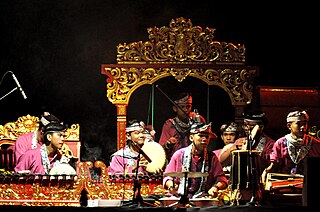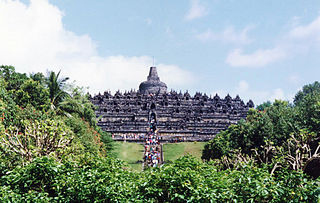
Gamelan degung is a form of Sundanese musical ensemble that uses a subset of modified gamelan instruments with a particular mode of degung scale. The instruments are manufactured under local conditions in towns in West Java such as Bogor and Bandung. Degung music is often played at public gatherings in West Java, such as at local elections, as well as many other events. There is international interest in degung as well among communities in other countries interested in Indonesian and gamelan music.

Gamelan surakarta A typical large, double gamelan in contemporary solo (Surakarta) will include, in the sléndro set, one saron panerus, two saron barung, one or two saron demung, one gendér panerus, one gender barung, one slenthem, one bonang panerus and one bonang barung, one gambang kayu, one siter or celempung, one rebab, one suling, one pair of kethuk and kempyang, one set of three to five kenong, one set of three to five kempul, one to three gong suwukan, and one gong ageng.

A gendèr is a type of metallophone used in Balinese and Javanese gamelan music. It consists of 10 to 14 tuned metal bars suspended over a tuned resonator of bamboo or metal, which are tapped with a mallet made of wooden disks (Bali) or a padded wooden disk (Java). Each key is a note of a different pitch, often extending a little more than two octaves. There are five notes per octave, so in the seven-note pélog scale, some pitches are left out according to the pathet. Most gamelans include three gendèr, one for sléndro, one for pelog pathet nem and lima, and one for pelog pathet barang.

A kempul is a type of hanging gong used in Indonesian gamelan. The kempul is a set of pitched, hanging, knobbed gongs, often made of bronze, wood, and cords. Ranging from 19 cm to 25,4 cm in diameter, the kempul gong has a flat surface with a protruding knob at the center and is played by hitting the knob with the "soft end of a mallet." "The wooden mallet used has a ball shape head with heavy padding on a short wooden handle. The number of kempul gongs present in a gamelan ensemble varies but, "although there can be two to ten kempul on one separate rack, it is common to have five kempul hanging on the same rack as the Gong ageng and gong siyem".

Gamelan beleganjur is one of the most popular styles of gamelan music in Bali. Its closest Western analogue is probably the Western military band.

Padangsidimpuan is a city in North Sumatra, Indonesia, and the former capital of South Tapanuli Regency, which surrounds the city. It has an area of 159.28 km2 and a population of 178,818 people at the 2000 census, which rose to 191,554 in the 2010 census and 225,105 at the 2020 Census; the official estimate as at mid 2023 was 236,217 - comprising 119,228 males and 116,989 females.

The bonang is an Indonesian musical instrument used in the Javanese gamelan. It is a collection of small gongs placed horizontally onto strings in a wooden frame (rancak), either one or two rows wide. All of the kettles have a central boss, but around it the lower-pitched ones have a flattened head, while the higher ones have an arched one. Each is tuned to a specific pitch in the appropriate scale; thus there are different bonang for pelog and slendro. They are typically hit with padded sticks (tabuh). This is similar to the other cradled gongs in the gamelan, the kethuk, kempyang, and kenong. Bonang may be made of forged bronze, welded and cold-hammered iron, or a combination of metals. In addition to the gong-shaped form of kettles, economical bonang made of hammered iron or brass plates with raised bosses are often found in village gamelan, in Suriname-style gamelan, and in some American gamelan. In central Javanese gamelan there are three types of bonang used:

The kempyang and ketuk are two instruments in the gamelan ensemble of Indonesia, generally played by the same player, and sometimes played by the same player as the kenong. They are important beat-keepers in the colotomic structure of the gamelan. Depending on the structure, they play different, repeating patterns every gongan. Not all structures use the kempyang, but the kempyang is never played without the ketuk.

The Kenong is a musical instrument of Indonesia used in the gamelan. It is a kind of gong and is placed on its side. It has the same length and width. Thus, it is similar to the bonang, kempyang, and ketuk, which are also cradled gongs. Kenongs are generally much larger than the aforementioned instruments. However, the kenong has a considerably higher pitch. Its sound stands out because of its unique timbre. The kenong sticks are taller than that of the bonang. The kenong is sometimes played by the same player as the kempyang and ketuk.

The panerusan instruments or elaborating instruments are one of the divisions of instruments used in Indonesian gamelan. Instead of the rhythmic structure provided by the colotomic instruments, and the core melody of the balungan instruments, the panerusan instruments play variations on the balungan. They are usually the most difficult instruments to learn in the gamelan, but provide the most opportunity for improvisation and creativity in the performer.
Imbal or imbalan is a technique used in Indonesian Javanese gamelan. It refers to a rapid alternation of a melodic line between instruments, in a way similar to hocket in medieval music or kotekan in Balinese gamelan. "A style of playing in which two identical or similar instruments play interlocking parts forming a single repetitive melodic pattern."
This imbal is a method of playing in which the nuclear theme is played by one of the nyaga's 'broken up' into half-values, what time another player beats alternately with the first, but in such a way that his tones, each of which comes between two of his colleague's, are always one step lower than the nuclear theme tone immediately preceding it. From practical considerations this imbal is, if possible, divided over two demungs; if only one such instrument is available, the two players sit facing each other. The player who beats the nuclear theme tones is said to play the gawé (...); the other one, the nginţil (...).

Tuban is a town located on the north coast of Java, in Tuban Regency, approximately 100 km (62 mi) west of Surabaya, the capital of East Java. Tuban Regency is surrounded by Lamongan Regency in the east, Bojonegoro Regency in the south, and Rembang Regency, Central Java in the west. Tuban town covers 21.29 km2 (8.22 sq mi) and in mid-2023 had an officially estimated population of 88,052.

The Wali Songo are revered saints of Islam in Indonesia, especially on the island of Java, because of their historic role in the spread of Islam in Indonesia. The word wali is Arabic for "trusted one" or "friend of God", while the word sanga is Javanese for the number nine.
Sunan Kalijaga was one of the "nine saints" of Javanese Islam. The "Kalijaga" title was derived from an orchard known as "Kalijaga" in Cirebon. Other accounts suggest that the name derives from his hobby of submerging himself in Kali. Others note that the name Kalijaga derived its nature from the Arabic notion of qadli dzaqa which means "holy leader" in the sultanate.

The Gamelan Sekaten is a ceremonial gamelan from central Java, Indonesia, played during the annual Sekaten festival. The word "sekaten" itself is derived from syahadatain or shahada, the first requirement for converting into Islamic faith. Traditionally it is played once per year, on the occasion of Mawlid, Muhammad's birthday, for the week from the 6-12 of the month of Mulud. On this celebration it is brought from the palace at 11 pm to two pavilions before the Great Mosque. It is played every day during that week except the Thursday night/Friday morning. On the eve of the birthday proper, it is returned at 11 pm.
Sunan Bonang was one of the Wali Songo, along with his father Sunan Ampel and his brother Sunan Drajat.
Bonang Road is a rural road in south-eastern Australia, running generally south–north. It links the Gippsland region coastal town of Orbost, Victoria and the highland Monaro region town of Bombala, New South Wales.

The Bonang River is a perennial river of the Snowy River catchment, located in the Alpine region of the Australian state of Victoria.
Bonang Dorothy Matheba, is a South African award-winning television presenter, radio personality, actress and social media personality. She is known for her flamboyant presenting skills and her signature voice. She presented the SABC 1 music show LIVE which built her spotlight in the industry. She is also known for being the first Black South African to be featured on numerous magazines.

A tifa totobuang is a music ensemble from the Maluku Islands, related to the kulintang orchestra. It consists of a set of a double row of gong chimes known as the totobuang and a set of tifa drums. It can also include a large gong.














